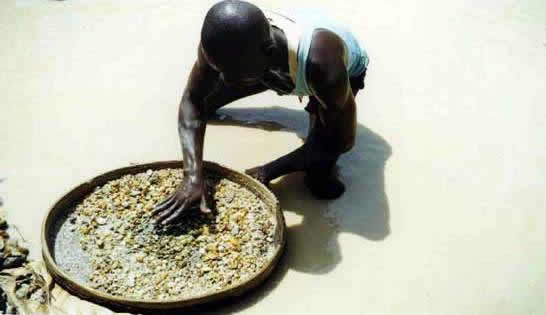OECD Guidelines: A replacement of the Kimberley Process? was the original name given by the organizers for Panel II at the Second Zimbabwe Diamond Conference that took place in Harare in early November. Though the original name of the panel discussion was changed, at the request of the Organisation for Economic Cooperation and Development (OECD), it didn’t seem to matter much to the officials from
Angola, Namibia, DRC, or Zimbabwe who were in attendance. Over the last few years, these officials have been following with some anxiety the activities of what is known as the Precious Stones Multi-Stakeholder Working Group (PS-MSWG), which endeavors to have the OECD Due Diligence Guidelines for the Sourcing of Conflict Minerals also issue specific rules for the industry’s diamond and precious stone production sectors.
Wanting more
 It is believed that such specific OECD Guidelines for precious stones (including diamonds) would add additional human rights elements to the Kimberley Process Certification Scheme (KPCS or KP) beyond its current scope of keeping conflict diamonds out of the industry and, essentially, widen the scope of the KP. The driving forces behind the PS-MSWG – a few major U.S. and British retail jewelers, Jewelers of America, Global Witness, and the U.S. government – are dissatisfied with the limited scope of the KP and want “more”; they seek sourcing comfort beyond the KP. The voluntary OECD Due Diligence Guidelines, if adopted, it is argued, could subsequently be incorporated in EU or other national laws – similar to the Dodd-Frank Act in the United States.
It is believed that such specific OECD Guidelines for precious stones (including diamonds) would add additional human rights elements to the Kimberley Process Certification Scheme (KPCS or KP) beyond its current scope of keeping conflict diamonds out of the industry and, essentially, widen the scope of the KP. The driving forces behind the PS-MSWG – a few major U.S. and British retail jewelers, Jewelers of America, Global Witness, and the U.S. government – are dissatisfied with the limited scope of the KP and want “more”; they seek sourcing comfort beyond the KP. The voluntary OECD Due Diligence Guidelines, if adopted, it is argued, could subsequently be incorporated in EU or other national laws – similar to the Dodd-Frank Act in the United States.
Mission impossible?
At the OECD, the highest authority and greatest expert on conflict mineral guidelines is Tyler Gillard, legal adviser and project head at this intergovernmental agency where he advises governments, regulators and refineries how to guard mostly against conflict gold. Squeezing in time between crucial meetings in Kinshasa, DRC, and in Lima, Peru, Gillard stopped in Harare to participate in a panel discussion that clearly had definite predispositions on the subject. Gillard was basically put in a “mission impossible” scenario, especially since Zimbabwe Mines Minister Walter Chidhakwa had expressed strong opposition to funding in the diamond sector by overseas organizations “that then believe they have the right to tell us what to do, how to develop, how to manage our African affairs.”
Tyler Gillard was facing an audience of close to 1,000 mostly African stakeholders, suspicious of any norms, guidelines, rules, etc., coming from the Western-developed nation-oriented OECD. Add this to the unfortunate circumstance that time constraints made it hardly possible to succinctly present a complicated subject, Gillard must have felt pressured, especially as he arrived at the conference hall directly from the airport only minutes before the start of the panel. Gillard shared the panel with Levy Rapoo, CEO of the South African Diamonds and Precious Metals Regulator; Kennedy Hamutenya, Diamond Commissioner of the Republic of Namibia; Paul M’Vika, the Angolan Chair of the KP’s Working Group on Artisanal and Alluvial Production (WGAAP); and Peter Meeus, the Chairman of the Dubai Diamond Exchange.
Comparing KPCS to OECD due diligence requirements
Gillard made it clear that the OECD Guidelines don’t say from where one must refrain from sourcing minerals, but rather how to effectively and successfully engage in conflict areas without negatively impacting one’s business reputation.
 “Our goal is to actually enable investment and trade of minerals in areas of conflict or high-risk by outlining and helping implement clear and reasonable procedures for private sector engagement, which are developed and owned by OECD and African countries, companies in the entire mineral supply chains and civil society. This will enable the mining and trade of minerals in areas of conflict or high-risk to stimulate growth, increase state revenues, prosperity, healthy and safe jobs and local development,” explained Gillard.
“Our goal is to actually enable investment and trade of minerals in areas of conflict or high-risk by outlining and helping implement clear and reasonable procedures for private sector engagement, which are developed and owned by OECD and African countries, companies in the entire mineral supply chains and civil society. This will enable the mining and trade of minerals in areas of conflict or high-risk to stimulate growth, increase state revenues, prosperity, healthy and safe jobs and local development,” explained Gillard.
Gillard succeeded in reassuring the audience (or at least in putting the audience more at ease) about two main areas of concern: that nothing will be done by his OECD Investment Division without the full cooperation and involvement of the African diamond producers; and that there are presently no plans at the OECD for a Precious Stones (and Diamonds) Guidelines to begin with. He also gave the OECD perspective on the issues pursued by the PS-MSWG.

